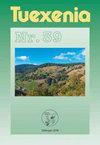乌克兰南部的古代聚落:当地和景观因素如何在草原植被的最后残余中塑造维管植物多样性模式?
IF 1.1
4区 生物学
Q3 PLANT SCIENCES
引用次数: 5
摘要
上个世纪的农业集约化导致了草原生境的大量丧失和破碎化。因此,在高度变化的景观中,草原是分散的,很少被保存下来。草原斑块通常保留在具有重要文化意义的遗址上,例如古代墓丘(kurgans)、古老墓地或古代定居点(土方工程)。因此,不仅是自然的,而且文物也具有很高的保护价值。我们假设古代定居点(公元前3 - 2世纪)可能作为草原栖息地岛屿,与草原植物保护的埋葬丘同等重要。本研究旨在探讨影响古聚落维管植物丰富度格局的地方因素和景观因素,并探讨古聚落在自然保护中的重要性。我们提出了以下问题:1)古聚落维管植物的物种丰富度有多高?2)古聚落是否具有与研究区内其他草原飞地相当的自然保护价值?3)哪些因素对古聚落物种丰富度和物种组成最重要?以古聚点面积、微生境多样性指数、造林程度、古聚点周围1 km缓冲带草原覆盖、到最近的聚落距离、古聚点周围1 km缓冲带聚落面积、年平均降水量等7个环境变量为变量,对总丰富度及其分类进行简单回归分析。在乌克兰南部下第聂伯罗盆地的18个古聚落中,记录到相当数量的原生植物(396种,占75.6%)、草原植物(239种,占45.6%)和非共生植物(225种,占42.9%),表明草原植物保存状况良好。微生境多样性指数对物种总丰富度的正向预测作用最为显著,其次是古聚落面积、古聚落周围的植被覆盖率和草原覆盖度。对非共生植物的丰富度也有同样的影响。到聚落的距离是外来物种丰富度的显著负向预测因子。我们的研究证实,古代定居点是有价值的草原植物飞地,物种丰富,相对而言,手稿收到2020年3月15日,接受2020年5月29日协调编辑:Balázs Deák 460与自然保护区和库尔干地区的植物区系相比,草原和非共生植物的比例很高。研究结果有助于更好地规划古聚点植物多样性的积极保护,如恢复古聚点周围的草原,维持小规模干扰和微生境多样性(牧场、刈割区、烧毁区、黄土或石灰岩采掘地等),并在一定程度上限制造林。本文章由计算机程序翻译,如有差异,请以英文原文为准。
Ancient settlements in Southern Ukraine : how do local and landscape factors shape vascular plant diversity patterns in the last remnants of grass steppe vegetation?
Agricultural intensification in the last century resulted in a significant loss and fragmentation of steppe habitats. As a result, steppes are scattered and rarely preserved in highly transformed landscapes. Steppe patches have often remained on sites with cultural importance, such as ancient burial mounds (kurgans), old cemeteries or ancient settlements (earthworks). Thus, not only natural but also cultural objects could show a high conservation value. We hypothesised that ancient settlements (3rd – 2nd century BC) may act as steppe habitat islands, equally important as e.g. burial mounds for steppe plant protection. The aim of this study was to examine the local and landscape factors affecting vascular plants’ richness patterns in ancient settlements and to check the importance of such ancient settlements for nature conservation. We asked the following questions: 1) How high is the species richness of vascular plants on ancient settlements? 2) Do ancient settlements have a nature conservation value comparable to other steppe enclaves of the studied zone? 3) Which factors are the most important for the species richness and species composition in ancient settlements? We analysed total richness and its separate categories as dependent variables in simple regressions against seven environmental variables such as ancient settlement’s area, microhabitat variety index, afforestation degree, steppe cover in 1 km buffer around an ancient settlement, distance to the closest settlements, area of settlements in 1 km buffer around an ancient settlement and mean annual precipitation. In 18 studied ancient settlements located in the Lower Dnipro basin (Southern Ukraine), we recorded a considerable number of native (396 species, 75.6%), steppe (239 species, 45.6%) and non-synanthropic plants (225 species, 42.9%), which indicated a good state of preservation of the steppe on these objects. The microhabitat variety index, as a measure of habitat heterogeneity, appeared to be the most significant positive predictor of total species richness, followed by ancient settlement’s area, afforestation degree and steppe cover around the ancient settlements. The same factors were significant for the richness of non-synanthropic plants. Distance to settlements was a significant negative predictor for established alien species richness. Our study confirmed that ancient settlements are valuable enclaves of steppe flora, surprisingly species-rich and of relatively Manuscript received 15 March 2020, accepted 29 May 2020 Co-ordinating Editor: Balázs Deák 460 high ratio of steppe and non-synanthropic plants compared to the flora of nature reserves and kurgans. Our results could help to better plan active protection of plant diversity on ancient settlements, e.g. through steppe restoration around the ancient settlements, maintenance of small-scale disturbance and microhabitat diversity (pastures, mown areas, burnt areas, loess or limestone extraction sites etc.) and limiting afforestation to a certain degree.
求助全文
通过发布文献求助,成功后即可免费获取论文全文。
去求助
来源期刊

Tuexenia
PLANT SCIENCES-
CiteScore
2.80
自引率
25.00%
发文量
0
期刊介绍:
Tuexenia publiziert Original- und Übersichtsarbeiten sowie Berichte zu Themen der Geobotanik / Vegetationsökologie und zu Nachbarwissenschaften wie Populationsökologie, Biodiversitätsforschung, Biozönologie, Renaturierungsökologie und ihren Anwendungen, vor allem im Naturschutz. Der geografische Schwerpunkt liegt in Zentraleuropa und angrenzenden Regionen.Tuexenia erscheint jährlich in einem Band, der etwa zur Jahresmitte fertig gestellt wird. Autoren erhalten von jeder Arbeit eine PDF-Datei und gemeinsam 20 Sonderdrucke kostenlos.
Die Qualität der wissenschaftlichen Manuskripte wird durch die Redaktion und einen Wissenschaftlichen Beirat (Peer Review) gesichert (s. auch die Manuskript-Richtlinien vor dieser Seite). Es werden keine Druckkosten erhoben. Tuexenia legt Wert auf allgemeine Online-Verfügbarkeit der Beiträge.
 求助内容:
求助内容: 应助结果提醒方式:
应助结果提醒方式:


